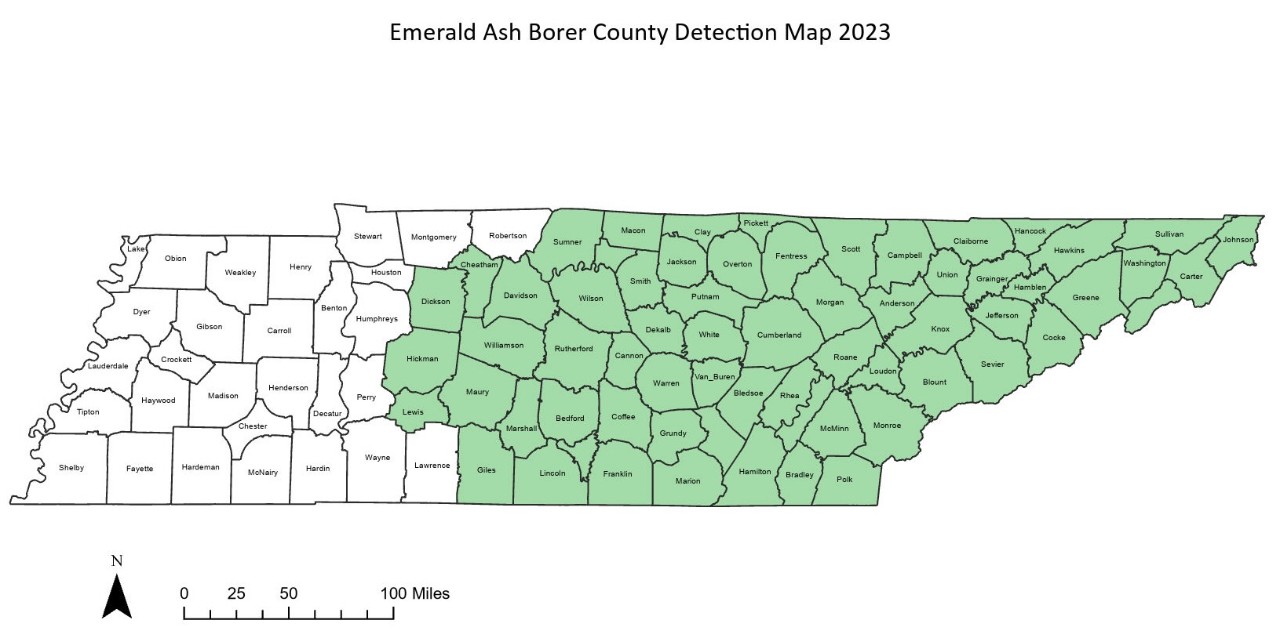Emerald Ash Borer
Originally from Asia, the emerald ash borer (Agrilus planipennis) was first discovered in Michigan in 2002. It has since caused widespread tree mortality and decline in ash (Fraxinus spp.) trees in 35 states, including Tennessee.
The emerald ash borer is transported mainly by humans through infected nursery stock, firewood, unprocessed saw logs, and other ash products. While this beetle has been a quarantined pest since its initial detection in the U.S., both the state and federal quarantines were lifted in 2021 following federal deregulation of this pest.

Larvae
The larvae are 1 to 1.2 inches long and are white or cream colored. The larvae make S shaped galleries under the bark of the ash tree. The larvae and galleries can usually be seen year-round.
Adults
The adult emerald ash borers are about 1/2 inch long, 1/8 inch wide, and are bronze, golden, or reddish green with darker metallic green wings. The underside is metallic purple-red. The adults can usually be seen from June to August.
Tree Infestations
Once the tree is infested and the emerald ash borer population builds, the leaves begin to wilt and branches die leaving a sparse canopy.
D shaped holes, which are 1/8 inch in wide and can be seen year-round, may be noticeable in the branch and trunk where the adult beetles emerged. Early detection can be difficult as it takes 1-3 years of infestation before an ash tree begins to show signs of mortality or decline. Tree mortality is caused when larvae feed on the tissue between the sapwood and the bark thus disrupting the transportation of nutrients and water within the tree. This disruption eventually causes the branches to die first followed by the entire tree. Some ash trees that are in decline will put out new shoots at the base of the tree called epicormic shoots. These can also serve as a characteristic sign that the ash tree is in decline from emerald ash borer.
In addition, several species of woodpeckers feed on emerald ash borer, and increased woodpecker damage on ash trees may indicate the presence of this beetle.
Identify Your Tree: Ash trees are easiest to identify when leaves are on the trees; however, it can be identified by looking at the bark and branching pattern in the wintertime.
- Bark - young bark is usually flaky; forms tall, interlacing ridges and deep furrows with age.
- Twigs - stout, gray to green-brown with small, lateral round buds opposite each other; terminal bud is large, brown, with leathery scales flanked by two small lateral buds.
- Leaves - oppositely arranged on twig, pinnately compound (leaf is made up of several leaflets attached to a leaf stem), and has 5 to 9 dark green leaflets (usually 7 or 9).
- Leaflets - either no stalks or very short stalks attached to the leaf stem; smooth or sometimes finely serrated on the upper half.
- Autumn color - green ash: yellow and orange; white ash: red and purple.





The emerald ash borer (EAB) was identified in Tennessee at a truck stop on I-40 in Knox County in July, 2010. Since that introduction, a total of 66 counties have confirmed the presence of EAB as it has spread across Tennessee. Ash trees serve as a component of residential trees planted along streets and in parks, as well as a component of forests in many areas of Tennessee. Because of this, EAB has caused significant economic costs in both these residential and forested land since its discovery in 2010.
County Distribution Map

Control Efforts
Trapping efforts in Tennessee have involved cooperation with USDA Animal and Plant Health Inspection Service, along with the aid of the Tennessee Department of Agriculture, Tennessee Department of Environment and Conservation, and the University of Tennessee.
Reporting damage can also help identify the distribution of emerald ash borer in Tennessee which is important for managing forests or residential landscapes that contain ash trees.

Keep ash trees healthy by watering, mulching, pruning, and protecting. Pesticides are available to help combat the emerald ash borer but are not always economically practical. Insecticides can have varying effectiveness, and typically any tree with >50% canopy thinning cannot effectively be treated with insecticides. Research is ongoing to develop more effective pesticides and other management options to control the emerald ash borer, such as the use of biological controls. Avoid “knee jerk” reactions such as harvesting uninfested ash trees. If removing landscape ash trees that are in decline, consider replanting with other native tree species depending on site conditions and other factors.
Contact a professional forester or your local TDF office for more information on ash and EAB management. Management decisions should consider: your current forest management objectives, the amount of ash in your forest, current ash markets, and your proximity to a known EAB infestation.
- Managing EAB: Decision Guide (Purdue University)
- Insecticide Options for Protecting Ash Trees from EAB (North Central IPM Center)
What Can You Do?
Don’t Move Firewood! Firewood is a very common transportation method for this beetle. Emerald ash borer can hide in firewood that has not been heat-treated, and then be accidentally moved from other states or from other areas within Tennessee. Using heat-treated firewood can help reduce the spread of forest pests that are often transported in firewood. EAB is also known to travel in unprocessed ash logs, ash nursery stock, and other ash commodities.
Don't Move Firewood - Protect Trees from Bugs (dontmovefirewood.org)
Learn to recognize what the signs and symptoms are of an infestation and what the emerald ash borer looks like in its various growth stages. Please contact your county agent, professional forester, or the Division of Forestry at 615.837.5432 if you suspect your ash tree is infected.
